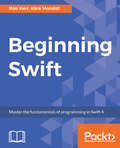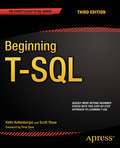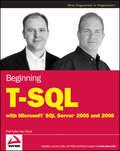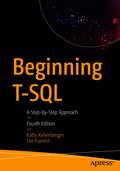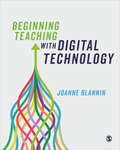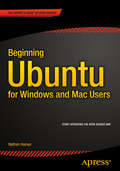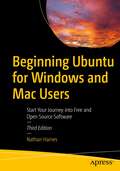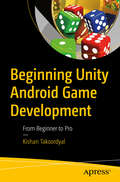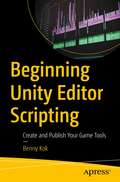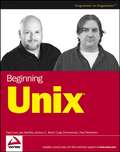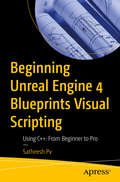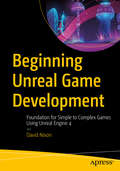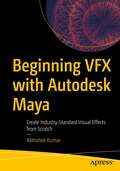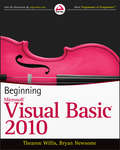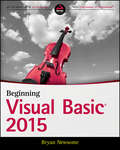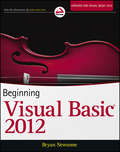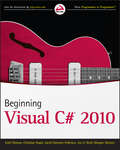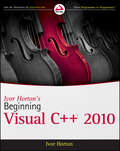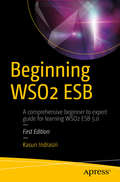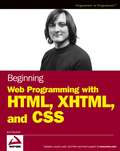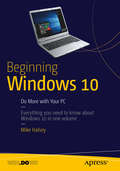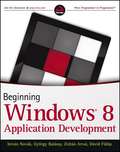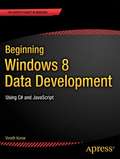- Table View
- List View
Beginning Swift [Book]: Master the fundamentals of programming in Swift 4
by Robert Kerr Kåre MorstølMaster the fundamentals of programming in Swift 4Key Features Covers theory and practice in equal parts Teaches you how to correctly structure and architect software using Swift Uses real-world examples to connect the theory to a professional setting Imparts expertise in the core Swift standard libraryBook DescriptionTake your first foray into programming for Apple devices with Swift.Swift is fundamentally different from Objective-C, as it is a protocol-oriented language. While you can still write normal object-oriented code in Swift, it requires a new way of thinking to take advantage of its powerful features and a solid understanding of the basics to become productive.This course helps you develop client-side and server-side applications, as well as web services using Swift. We'll begin with exploring the fundamental Swift programming concepts, language structure, and the Swift programming syntax. Then, we'll learn to create original custom operators with Swift operators, branching, and loops.Moving on, we'll learn how to run application codes and compile errors. Having made progress with it, we'll see how Swift compares to other computer languages and how to transform your thinking. Then, master the usage of key language elements, such as strings and collections. Finally, grasp how Swift supports modern application development using advanced features, such as built-in Unicode support and higher-order functions.This is an introductory course to the Swift programming language with Xcode.After completing this course, students will be well-prepared to begin developing native end-user applications for iOS or macOS, or to develop server-side (back-end) application and web services using Swift on Linux.What you will learn Explore the fundamental Swift programming concepts, language structure, and the Swift programming syntax Learn how Swift compares to other computer languages and how to transform your thinking to leverage new concepts such as optionals and protocols Master how to use key language elements, such as strings and collections Grasp how Swift supports modern application development using advanced features, such as built-in Unicode support and higher-order functions.Who this book is forIf you are seeking fundamental Swift programming skills, in preparation for learning to develop native applications for iOS or macOS, this book is the best for you. You don’t need to have any prior Swift knowledge; however, object-oriented programming experience is desired.
Beginning T-SQL
by Scott Shaw Kathi KellenbergerBeginning T-SQL is a performance-oriented introduction to the T-SQL language underlying the Microsoft SQL Server database engine. T-SQL is essential in writing SQL statements to get data into and out of a database. T-SQL is the foundation for business logic embedded in the database in the form of stored procedures and functions. Beginning T-SQL starts you on the path to mastering T-SQL, with an emphasis on best-practices and sound coding techniques leading to excellent performance. This new edition is updated to cover the essential features of T-SQL found in SQL Server 2014, 2012, and 2008. Beginning T-SQL begins with an introduction to databases, normalization, and to SQL Server Management Studio. Attention is given to Azure SQL Database and how to connect to remote databases in the cloud. Each subsequent chapter teaches an aspect of T-SQL, building on the skills learned in previous chapters. Exercises in most chapters provide an opportunity for the hands-on practice that leads to true learning and distinguishes the competent professional. Important techniques such as windowing functions are covered to help write fast executing queries that solve real business problems. A stand-out feature in this book is that most chapters end with a 'Thinking About Performance' section. These sections cover aspects of query performance relative to the content just presented. They'll help you avoid beginner mistakes by knowing about and thinking about performance from Day 1. Imparts best practices for writing T-SQLHelps you avoid common errorsShows how to write scalable code for good performance
Beginning T-SQL with Microsoft SQL Server 2005 and 2008
by Paul Turley Dan WoodIf you've not programmed with Transact-SQL, this book is for you.It begins with an overview of SQL Server query operations and tools used with T-SQL, and covers both the 2005 and 2008 releases of SQL Server query tools and the query editor. The book then moves to show you how to design and build applications of increasing complexity. Other important tasks covered include full text indexing, optimizing query performance, and application design and security considerations. The companion website also provides all of the code examples from the book.
Beginning T-SQL: A Step-by-Step Approach
by Kathi Kellenberger Lee EverestGet a performance-oriented introduction to the T-SQL language underlying the Microsoft SQL Server and Azure SQL database engines. This fourth edition is updated to include SQL Notebooks as well as up-to-date syntax and features for T-SQL on-premises and in the Azure cloud. Exercises and examples now include the WideWorldImporters database, the newest sample database from Microsoft for SQL Server. Also new in this edition is coverage of JSON from T-SQL, news about performance enhancements called Intelligent Query Processing, and an appendix on running SQL Server in a container on macOS or Linux. Beginning T-SQL starts you on the path to mastering T-SQL with an emphasis on best practices. Using the sound coding techniques taught in this book will lead to excellent performance in the queries that you write in your daily work. Important techniques such as windowing functions are covered to help you write fast-executing queries that solve real business problems.The book begins with an introduction to databases, normalization, and to setting up your learning environment. You will learn about the tools you need to use such as SQL Server Management Studio, Azure Data Studio, and SQL Notebooks. Each subsequent chapter teaches an aspect of T-SQL, building on the skills learned in previous chapters. Exercises in most chapters provide an opportunity for the hands-on practice that leads to true learning and distinguishes the competent professional. A stand-out feature in this book is that most chapters end with a Thinking About Performance section. These sections cover aspects of query performance relative to the content just presented, including the new Intelligent Query Processing features that make queries faster without changing code. They will help you avoid beginner mistakes by knowing about and thinking about performance from day 1.What You Will LearnInstall a sandboxed SQL Server instance for learningUnderstand how relational databases are designedCreate objects such as tables and stored proceduresQuery a SQL Server table Filter and order the results of a queryQuery and work with specialized data types such as XML and JSONApply modern features such as window functionsChoose correct techniques so that your queries perform wellWho This Book Is ForAnyone who wants to learn T-SQL from the beginning or improve their T-SQL skills; those who need T-SQL as an additional skill; and those who write queries such as application developers, database administrators, business intelligence developers, and data scientists. The book is also helpful for anyone who must retrieve data from a SQL Server database.
Beginning Teaching with Digital Technology
by Joanne BlanninTeachers are now expected to use technology to enhance students’ learning, but what does this mean in the classroom and how can you apply it effectively to subject teaching? This book, for pre-service and qualified teachers, offers you a guide for using technology in primary and secondary schools, including how to decide which technology resource to use, safeguarding and ethical considerations and computer coding in the classroom. Further guidance is provided on using technology across the learning areas of literacy, mathematics, STEM and the arts. Key features include: · Classroom scenarios which tackle common challenges faced by teachers and how to resolve them · Examples of best practice technology use in early childhood settings, primary and secondary classrooms · A future-proofed approach focusing on theory-informed best practice in an ever-changing world of devices and software Essential reading for pre-service teacher education students in both primary and secondary education courses on undergraduate and postgraduate routes into teaching and for qualified teachers looking to deepen their professional knowledge. Joanne Blannin is Senior Lecturer in Digital Transformations at Monash University.
Beginning Teaching with Digital Technology
by Joanne BlanninTeachers are now expected to use technology to enhance students’ learning, but what does this mean in the classroom and how can you apply it effectively to subject teaching? This book, for pre-service and qualified teachers, offers you a guide for using technology in primary and secondary schools, including how to decide which technology resource to use, safeguarding and ethical considerations and computer coding in the classroom. Further guidance is provided on using technology across the learning areas of literacy, mathematics, STEM and the arts. Key features include: · Classroom scenarios which tackle common challenges faced by teachers and how to resolve them · Examples of best practice technology use in early childhood settings, primary and secondary classrooms · A future-proofed approach focusing on theory-informed best practice in an ever-changing world of devices and software Essential reading for pre-service teacher education students in both primary and secondary education courses on undergraduate and postgraduate routes into teaching and for qualified teachers looking to deepen their professional knowledge. Joanne Blannin is Senior Lecturer in Digital Transformations at Monash University.
Beginning Ubuntu for Windows and Mac Users: Start Your Journey Into Free And Open Source Software
by Nathan HainesBeginning Ubuntu for Windows and Mac Users is your comprehensive guide to using Ubuntu. You already know how to use a computer running Windows or OS X, but learning a new operating system can feel daunting. If you've been afraid to try Ubuntu because you don't know where to start, this book will show you how to get the most out of Ubuntu for work, home, and play. You'll be introduced to a wide selection of software and settings that will make your computer ready to work for you. Ubuntu makes your computing life easy. Ubuntu's Software Updater keeps all of your software secure and up-to-date. Browsing the Internet becomes faster and safer. Creating documents and sharing with others is built right in. Enjoying your music and movie libraries helps you unwind. In addition to a tour of Ubuntu's modern and easy-to-use interface, you'll also learn how to: * Understand the advantages of Ubuntu and its variants--Kubuntu, Xubuntu, and more * Install Ubuntu on its own or alongside your computer's existing operating system * Search Ubuntu's catalog of thousands of applications--all ready to install with a single click * Work with files and disks that were created with Windows and OS X * Run simple, interesting tasks and games using the command line * Customize Ubuntu in powerful ways and get work done with virtual machines Ubuntu is the world's third most popular operating system and powers desktop and laptop computers, servers, private and public clouds, phones and tablets, and embedded devices. There's never been a better time to install Ubuntu and move to an open source way of life. Get started with Beginning Ubuntu for Windows and Mac Users today!
Beginning Ubuntu for Windows and Mac Users: Start Your Journey into Free and Open Source Software
by Nathan HainesCompletely updated for this exciting third edition, Beginning Ubuntu for Windows and Mac Users will help you start your journey into Free and Open Source Software with Ubuntu 22.04.1 LTS with GNOME 42.This book is a friendly guide to installing and running Ubuntu for people who are already efficient and happy with Windows or macOS computers. It teachers new Ubuntu users how to navigate their new operating system, perform basic tasks and suggests specific applications to handle routine tasks.You'll start by installing Ubuntu and its related “flavors” (Kubuntu, Ubuntu MATE, etc.) and how they differ from each other. The rest of the book breaks down application suggestions by broad categories to fill in gaps in the default installed system, or suggest fun things that the reader might not have even thought of. The command line is handled after you are comfortable with the system and ready for something interesting but different. It's presented as a powerful interface that can either be approached casually as a unique method of interacting with the computer, as an occasional tool to use, or as a fun way to get in touch with an early way of using a computer.A brief look at “power user” topics gives advice on managing running processes, installing alternate desktop software, using virtual desktops and creating virtual machines. It’s a great way to round off the book with starting points for advanced topics that are more specialty topics. An appendix describes the Ubuntu release schedule, naming, and timing.The book is designed to function as a “travel guide” to Ubuntu, offering both a scenic tour through some of the great software in Ubuntu in a practical “here’s what you can do with this” style as well as a comprehensive reference guide that the reader can return to over and over to learn how to accomplish specific tasks. What You'll LearnUnderstand the advantages of Ubuntu and its variants—Kubuntu and XubuntuInstall Ubuntu on its own or alongside your computer's existing operating systemSearch Ubuntu's catalog of thousands of applicationsWork with files and disks that were created with Windows and OS XRun simple, interesting tasks and games using the command lineCustomize Ubuntu in powerful ways and get work done with virtual machinesWho This Book Is ForBeginning to intermediate computer users with Windows 7 or OS X or later experience
Beginning Ubuntu for Windows and Mac Users: Start your Journey into Free and Open Source Software
by Nathan HainesBeginning Ubuntu for Windows and Mac Users is your comprehensive guide to using Ubuntu. You already know how to use a computer running Windows or OS X, but learning a new operating system can feel daunting. If you've been afraid to try Ubuntu because you don't know where to start, this book will show you how to get the most out of Ubuntu for work, home, and play. You'll be introduced to a wide selection of software and settings that will make your computer ready to work for you. Ubuntu makes your computing life easy. Ubuntu's Software Updater keeps all of your software secure and up-to-date. Browsing the Internet becomes faster and safer. Creating documents and sharing with others is built right in. Enjoying your music and movie libraries helps you unwind. In addition to a tour of Ubuntu's modern and easy-to-use interface, you'll also learn how to: * Understand the advantages of Ubuntu and its variants--Kubuntu, Xubuntu, and more * Install Ubuntu on its own or alongside your computer's existing operating system * Search Ubuntu's catalog of thousands of applications--all ready to install with a single click * Work with files and disks that were created with Windows and OS X * Run simple, interesting tasks and games using the command line * Customize Ubuntu in powerful ways and get work done with virtual machines Ubuntu is the world's third most popular operating system and powers desktop and laptop computers, servers, private and public clouds, phones and tablets, and embedded devices. There's never been a better time to install Ubuntu and move to an open source way of life. Get started with Beginning Ubuntu for Windows and Mac Users today!
Beginning Unity Android Game Development: From Beginner to Pro
by Kishan TakoordyalMaster the art of programming games for Android using the Unity3D game engine. This book will help you understand basic concepts of game development in Unity. By the end of Beginning Unity Android Game Development, you will have the knowledge to confidently build an Android game. The book starts by explaining simple programming concepts to make beginners comfortable with the jargon. You will then learn to navigate around the Unity interface and use basic tools (hand, move, rotate, scale, and rect). You will also be acquainted with the creation of basic 3D objects in the game while understanding the purpose of several of Unity’s windows. In the last chapters, you will learn to create a simple game for Android using the concepts studied in the previous chapters. Scripts will be written to handle the behaviors of the player and enemies as well as to handle other aspects of the game. The author shares tips along the way to help improve in-game performance, such as switching to the universal rendering pipeline when targeting mobile platforms. At the end of the book, you will have a solid knowledge in making basic Android games that can be upgraded later to make more complex games.What You Will LearnExplore basic Unity and C# programming concepts and scripting for Android gamesNavigate around the Unity interface and use its basic toolsMake the most of popular components and features of UnityWrite an Android game with optimizations Who This Book Is For Absolute beginners learning to program games for the Android platform using Unity3D. Basic knowledge of programming would be beneficial for the reader but is not required.
Beginning Unity Editor Scripting: Create and Publish Your Game Tools
by Benny KokLearn about editor scripting in Unity, including different possible methods of editor customization to fit your custom game workflow or even to create assets that could be published on the Asset Store to earn a passive income. The knowledge of editor scripting, although rarely covered in books, gives a game developer insight into how things work in Unity under the hood, which you can leverage to create custom tools that empower your unique game idea. This book starts with the very basics of editor scripting in Unity, such as using built-in attributes to customize your component’s editor and creating custom editors and windows with IMGUI and UI Toolkit. Next, we move to a general use case example by creating an object spawner EditorTool for the scene view. Later, we dive straight to in-depth stats and detailed case studies of two Unity assets: ProArray and Rhythm Game Starter. Here you’ll get more context on how editor scripting is used in published assets. You will also learn how to set up a better workflow for editor scripting, asset publishing, maintenance, and iterative updates. You will leverage the power of modern web technology to build a documentation site with GitBook and DocFX. Finally, you will see some tips and tricks for automating asset versioning and changelogs. What You Will Learn Get started with Editor scripting in Unity Work with advanced editor topics such as custom EditorWindows and EditorTool Structure your C# code with namespaces and asmdef Use IMGUI and UI Toolkit for creating editor GUIs Master packaging and selling your own editor tools Set up a better workflow for asset publishing, maintenance, and iterative updates Who This Book Is For Readers who want to learn about editor scripting to improve their game-development process and create tools for themselves. Moderate experience with C# and a fundamental knowledge of Unity is expected.
Beginning Unix
by Paul Love Jeremy C. Reed Craig Zimmerman Paul Weinstein Joe MerlinoCovering all aspects of the Unix operating system and assuming no prior knowledge of Unix, this book begins with the fundamentals and works from the ground up to some of the more advanced programming techniques The authors provide a wealth of real-world experience with the Unix operating system, delivering actual examples while showing some of the common misconceptions and errors that new users make Special emphasis is placed on the Apple Mac OS X environment as well as Linux, Solaris, and migrating from Windows to Unix A unique conversion section of the book details specific advice and instructions for transitioning Mac OS X, Windows, and Linux users
Beginning Unreal Engine 4 Blueprints Visual Scripting: Using C++: From Beginner to Pro
by Satheesh PvDiscover how Unreal Engine 4 allows you to create exciting games using C++ and Blueprints. This book starts with installing, launching, and examining the details of Unreal Engine. Next, you will learn about Blueprints and C++ and how to leverage them. The following chapters talk in detail about gameplay, basic physics, and ray-casting for game development in Unreal Engine. Furthermore, you’ll create material, meshes, and textures. The last chapter brings all the concepts together by building a demo game. By the end of the book, you’ll be equipped with the know-how and techniques needed to develop and deploy your very own game in Unreal Engine. What You Will Learn Discover Blueprints and how to apply them in Unreal Engine 4 Get started with C++ programming in Unreal Engine 4 Apply the concepts of physics and ray-casting Work with the Gameplay Framework Who This Book Is For Beginners interested in learning Blueprints visual scripting and C++ for programming games in Unreal Engine 4 would find this book useful.
Beginning Unreal Game Development: Foundation for Simple to Complex Games Using Unreal Engine 4
by David NixonGet started creating video games using Unreal Engine 4 (UE4) and learning the fundamentals of game development. Through hands-on, step-by-step tutorials, you will learn to design engaging environments and a build solid foundation for more complex games. Discover how to utilize the 3D game design software behind the development of immensely popular games for PC, console, and mobile. Beginning Unreal Game Development steers you through the fundamentals of game development with UE4 to design environments that both engage the player and are aesthetically pleasing. Author David Nixon shows you how to script logic, define behaviors, store data, and create characters. You will learn to create user interfaces, such as menus, load screens, and head-up displays (HUDs), and manipulate audio to add music, sound effects, and dialogue to your game. The book covers level editors, actor types, blueprints, character creation and control, and much more. Throughout the book, you’ll put theory into practice and create an actual game using a series of step-by-step tutorials. With a clear, step-by-step approach, Beginning Unreal Game Development builds up your knowledge of Unreal Engine 4 so you can start creating and deploying your own 3D video games in no time. What You Will Learn Learn the fundamentals of game designUnderstand how to use Unreal Engine 4Design amazing levels for your characters to play inScript logic to control the behavior of the world you create Who This Book Is ForThis book is for beginners with no prior game design or programming experience. It is also intended for video game enthusiasts who are brand-new to the world of game development and want to learn how to design a game from scratch using UE4.
Beginning VFX with Autodesk Maya: Create Industry-Standard Visual Effects from Scratch
by Abhishek KumarDive into the nuances of visual effects (VFX) design, from planning to execution, using Autodesk Maya. This book introduces the methods and techniques required for your first foray into 3D FX generation from scratch. You will start with the fundamentals of visual effects, including a history of VFX, tools and techniques for creating believable visual effects, and popular tools used in the industry. Next, you are introduced to Autodesk Maya and its various components that make it a favorite among professionals. You will learn how to create rigid body collisions and simulate realistic particles such as dust, fire, water, and more.This book also presents strategies for creating a vortex, rain, hair, fluids, and other soft body simulations and also demonstrates nature element simulations for computer-generated production. At the end of the book, there is a capstone project to make your own visual effects scene in a practical way. After going through this book, you will be able to start building computer-generated visual effects from your imagination through to production.What You Will LearnUnderstand the basic physics behind effect creationCreate 3D visual effects scenes from scratchKnow the details of dynamic simulation in the computer generation space using various functionalities available in Autodesk MayaWho This Book Is ForBeginning-level users; students from the field of visual effects design, 3D modeling, and simulation; game designers; those creating computer graphics; FX artists and aspirants looking for a career in the field of 3D
Beginning Visual Basic 2010
by Thearon Willis Bryan NewsomeVisual Basic 2010 offers a great deal of functionality in both tools and language. No one book could ever cover Visual Basic 2010 in its entirety--you would need a library of books. What this book aims to do is to get you started as quickly and easily as possible. It shows you the roadmap, so to speak, of what there is and where to go. Once we've taught you the basics of creating working applications (creating the windows and controls, how your code should handle unexpected events, what object-oriented programming is, how to use it in your applications, and so on) we'll show you some of the areas you might want to try your hand at next.
Beginning Visual Basic 2012
by Bryan NewsomeThe ultimate beginner's guide to programming in Visual Basic 2012 Visual Basic, used to write Windows applications and web apps with ASP. NET, is an essential language for beginning programmers. Using the time-tested Wrox approach, this guide provides a step-by-step format that gets beginners up and running quickly and confidently. Essential topics covered include writing Windows applications, working with dialog boxes and menus, object oriented programming techniques, programming for graphics, using Visual Basic with ASP. NET for web apps, and dealing with data access and SQL Server. Visual Basic is a popular first language for beginning programmers; this Wrox beginner's guide covers all aspects of the newest version Uses a basic, step-by-step approach to help beginners learn quickly and easily Covers essential topics including flow control, data structure, writing Windows applications, error handling and debugging, objects and object oriented techniques, and class libraries Explains Windows Forms, graphics programming, accessing databases, web programming using Visual Basic with ASP. NET, data access, SQL Server, ADO. NET, and XML Beginning Visual Basic 2012 is a must-have for programming newcomers who want to get a solid footing in one of the most important programming languages.
Beginning Visual Basic 2012
by Bryan NewsomeThe ultimate beginner's guide to programming in Visual Basic 2012 Visual Basic, used to write Windows applications and web apps with ASP.NET, is an essential language for beginning programmers. Using the time-tested Wrox approach, this guide provides a step-by-step format that gets beginners up and running quickly and confidently. Essential topics covered include writing Windows applications, working with dialog boxes and menus, object oriented programming techniques, programming for graphics, using Visual Basic with ASP.NET for web apps, and dealing with data access and SQL Server. Visual Basic is a popular first language for beginning programmers; this Wrox beginner's guide covers all aspects of the newest version Uses a basic, step-by-step approach to help beginners learn quickly and easily Covers essential topics including flow control, data structure, writing Windows applications, error handling and debugging, objects and object oriented techniques, and class libraries Explains Windows Forms, graphics programming, accessing databases, web programming using Visual Basic with ASP.NET, data access, SQL Server, ADO.NET, and XML Beginning Visual Basic 2012 is a must-have for programming newcomers who want to get a solid footing in one of the most important programming languages.
Beginning Visual C# 2010
by Christian Nagel Karli Watson Morgan Skinner Jacob Hammer Pedersen Jon D. ReidUpdate to Wrox's leading C# book for beginners Get ready for the next release of Microsoft's C# programming language with this essential Wrox beginner's guide. Beginning Microsoft Visual C# 2010 starts with the basics and brings you thoroughly up to speed. You'll first cover the fundamentals such as variables, flow control, and object-oriented programming and gradually build your skills for Web and Windows programming, Windows forms, and data access. Step-by-step directions walk you through processes and invite you to "Try it Out," at every stage. By the end, you'll be able to write useful programming code following the steps you've learned in this thorough, practical book. The C# 4 programming language version will be synonymous with writing code with in C# 2010 in Visual Studio 2010, and you can use it to write Windows applications, Web apps with ASP. NET, and Windows Mobile and Embedded CE apps Provides step-by-step instructions for mastering topics such as variables, flow controls, and object-oriented programming before moving to Web and Windows programming and data access Addresses expressions, functions, debugging, error handling, classes, collections, comparisons, conversions, and more If you've always wanted to master Visual C# programming, this book is the perfect one-stop resource. Note: CD-ROM/DVD and other supplementary materials are not included as part of eBook file.
Beginning Visual C++® 2010
by Ivor HortonThe leading author of programming tutorials for beginners introduces you to Visual C++ 2010 Ivor Horton is the preeminent author of introductory programming language tutorials; previous editions of his Beginning Visual C++ have sold nearly 100,000 copies. This book is a comprehensive introduction to both the Standard C++ language and to Visual C++ 2010; no previous programming experience is required. All aspects of the 2010 release are covered, including changes to the language and the C++ standard. . Microsoft Visual C++ is one of the most popular C++ development environments and compilers, used by hundreds of thousands of developers Ivor Horton's approach to programming tutorials has achieved a huge following; this book gives beginning programmers a comprehensive introduction to both Standard C++ and Visual C++ 2010 Covers all the language changes in Visual C++ 2010, library additions, new MFC features, changes in the Visual Studio development environment, and more Also includes a brief introduction to programming for multicore processors in native C++ and C++/CLR processors Nearly 100,000 copies of this book have been sold in previous editions Beginners seeking a complete education in Visual C++ will find everything they need in Ivor Horton's Beginning Visual C++ 2010. Note: CD-ROM/DVD and other supplementary materials are not included as part of eBook file.
Beginning WSO2 ESB
by Kasun IndrasiriGain a strong foundation of core WSO2 ESB concepts and acquire a proven set of guidelines designed to get you started with WSO2 ESB quickly and efficiently. This book focuses on the various enterprises integration capabilities of WSO2 ESB along with a broad range of examples that you can try out. From beginning to the end, Beginning WSO2 ESB effectively guides you in gradually building expertise in enterprise integration with WSO2 ESB for your SOA infrastructure. Nowadays successful enterprises rely heavily on how well the underlying software applications and services work together to produce a unified business functionality. This enterprise integration is facilitated by an Enterprise Service Bus (ESB). This book provides comprehensive coverage of the fundamentals of the WSO2 ESB and its capabilities, through real-world enterprise integration use cases. What You'll Learn Get started with WSO2 ESB Discover message processing techniques with WSO2 ESB Integrate REST and SOAP services Use enterprise messaging techniques: JMS, AMQP, MQTT Manage file-based integration and integrate with proprietary systems such as SAP Extend and administrate WSO2 ESB Who This Book Is For: All levels of IT professionals from developers to integration architects who are interested in using WSO2 ESB for their SOA infrastructure.
Beginning Web Programming with HTML, XHTML, and CSS
by Jon DuckettWhat is this book about?Beginning Web Programming with HTML, XHTML, and CSS teaches you how to write Web pages using HTML, XHTML, and CSS. It follows standards-based principles, but also teaches readers ways around problems they are likely to face using (X)HTML.While XHTML is the "current" standard, the book still covers HTML because many people do not yet understand that XHTML is the official successor to HTML, and many readers will still stick with HTML for backward compatibility and simpler/informal Web pages that don't require XHTML compliance.The book teaches basic principles of usability and accessibility along the way, to get users into the mode of developing Web pages that will be available to as many viewers as possible from the start. The book also covers the most commonly used programming/scripting language -- JavaScript -- and provides readers with a roadmap of other Web technologies to learn after mastering this book to add more functionality to their sites.
Beginning Windows 10: Do More with Your PC
by Mike HalseyBeginning Windows 10 takes you through the new features of this amazing new operating system, revealing some of its surprising capabilities, and helping you customize it to suit you. Whether you are new to Windows, or you want to get up to speed with the latest features and changes, this book has everything you need to get started. Author Mike Halsey shows you how to create an environment for school, work, and play that puts the important things at your fingertips, while combining them in ways you never thought possible. Learn how to carry your personalized Windows experience with you as part of your Microsoft account instead of having it tied to one device, while also keeping everything safe, secure and backed up, so you can enjoy peace of mind with your new PC. With the right start, your PC can become a tool that works for you, not against you, and leaves more of your time and energy free for the things that matter to you. Beginning Windows 10 shows you how. What you'll learn About the ins and outs of the Windows 10 interface and its new features How to personalize your Windows experience to give trouble-free performance How to manage your Microsoft account across different devices and services in the home, at work, and on the move How to maximize your productivity with Windows 10 How to secure and configure Windows 10 to guarantee a safe and secure experience How to use, hack and manipulate Windows to enable advanced customization Who this book is for Beginning Windows 10 is for people new to Windows or who want to get up to speed with the latest version. This book also can help people who already know how to perform routine tasks learn how to get more out of Windows, their computer and their time. Whether you want to get up and running with Windows 10, or want to go to the next level and learn useful ways to minimize problems, maximize performance, and optimize your overall Windows experience, this book is for you. Table of Contents Chapter 1: Introducing Windows 10 Chapter 2: Finding your Way Around Windows 10 Chapter 3: Connecting to Networks and the Internet Chapter 4: Sharing with Family and Friends Chapter 5: Organizing and Searching Your PC and the Internet Chapter 6: Managing Your Windows Ecosystem and Devices Chapter 7: Printing and Managing Printers Chapter 8: Having Fun with Games, Photos, Music, and Video Chapter 9: Maximizing Your Productivity Chapter 10: Personalizing Your Windows Experience Chapter 11: Making Windows 10 More Accessible and Easier to Use Chapter 12: Keeping Yourself, Your Files and Your Computer Safe Chapter 13: Maintaining and Backing up Your Computer and Files Chapter 14: Advanced Configuration and Customization Chapter 15: Getting Started with Virtualization Chapter 16: Installing Windows 10 on Your Computer Appendix A: Windows 10 Touch Gestures Appendix B: Windows 10 Shortcut Keys Appendix C: Advanced Query Syntax for Search Appendix D: Windows 10 Features by Edition Appendix E: Upgrading Your Computer
Beginning Windows 8 Application Development
by Zoltan Arvai David Fulop Istv?n Nov?k György Bal SsyLearn to use exciting new development tools and create applications for Windows 8If you're a beginning developer, there's no better place to get up to speed on the Windows 8 SDK than this Wrox guide. A team of Microsoft experts provides a complete course in Windows 8 programming, helping you take full advantage of the innovative new SDK. Written in an easy-to-read style, this book is packed with reusable examples that showcase the endless possibilities of the Windows SDK and also introduces the new Windows 8 app store. It explains how to set up the development environment and covers user interface design, using special effects and graphics, working with C# and C++, and much more.Provides a complete introduction to the Windows SDK and Windows 8, starting with setting up the development environment and building your first applicationCovers user interface design, touch- and event-driven design elements, leveraging windows-based services, and offline application development with HTML 5Explores creating C# applications for the Windows 8 system, XNA 4 and Silverlight 5 considerations, and the role of C++Shows how to debug, certify and deploy your applicationsIntroduces the new Windows 8 app store and offers advice on marketing your appsBeginning Windows 8 Application Development is perfect for anyone who's ready to get started developing apps for the exciting new Windows 8 OS.
Beginning Windows 8 Data Development: Using C# and JavaScript
by Vinodh KumarThis book introduces novice developers to a range of data access strategies for storing and retreiving data both locally and remotely. It provides you with a range of fully working data access solutions and the insight you need to know when, and how, to apply each of the techniques to best advantage. Focussing specifically on how the Windows 8 app developer can work with the Windows Runtime (often called Windows RT) framework this book provides careful analysis of the many options you have open to you, along with a comparision of their strengths and weaknesses under different conditions. With the days of a single database being the right choice for almost all development projects long gone. You will lean that the right choice for your app now depends on a variety of factors and getting it right will be critical to your customer's end user experience. We cover a range of data access strategies ranging from storing and retrieving data locally using the JET API, to using the most popular open and closed source database products like SQLite and SQL Server. We look at how lightweight HTML and JavaScript apps work well with equally feather-weight data stores like IndexedDB. We'll also introduce you to more advanced data access techniques like REST (JSON), WCF RIA Services, ASP. NET MVC 4 Web API and Windows Azure that can hugely expand the horizons of what it is possible for your app to do as storage - and even processing - are taken beyond the confines of your user's device. By the time you have read this book you will be familiar with the key data access considerations you will need to evaluate as you build you apps and you will be able to confidently select the data access architecture that is most appropriate to the app you want to build. What you'll learn Understand the data access capability of WinRT Explore the various data access strategies Understand local storage in Windows 8 Apps Discover how to use HTML5 indexedDB as an offline database Use SQLite and SQL Server with Windows 8 Apps Develop ASP. NET MVC 4 Web API data stores Learn how to consume data through a WCF Service Integrate your app with Public Web Services using REST See how SQL Azure can extend your Windows 8 Apps Who this book is for This book is for all the . NET, iOS, Android and Windows Phone app developers looking to develop data driven Windows 8 style apps. You should be comfortable with basic programming concepts and have worked with simple data stores previously. Table of Contents Introducing Windows 8 development from a data perspective Windows 8 Modern app data access strategies Selecting the right strategy for your app Local Data Access I : JET API Local Data Access: II: IndexedDB Dealing with Application Data WCF RIA Services ASP. NET Web API SQL Databases Windows Phone 8 Data Access
